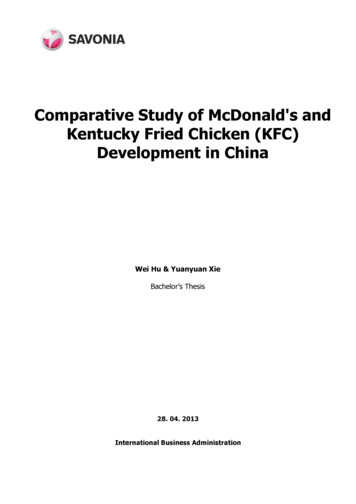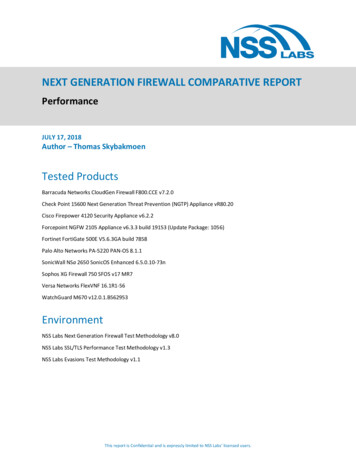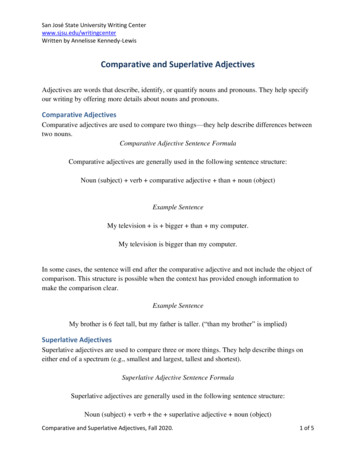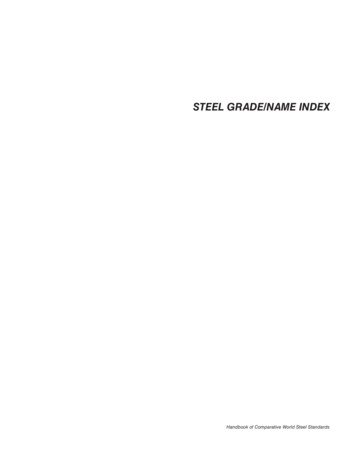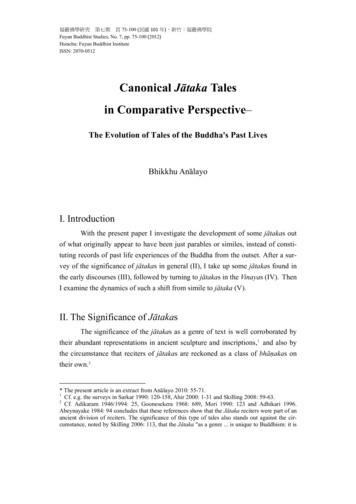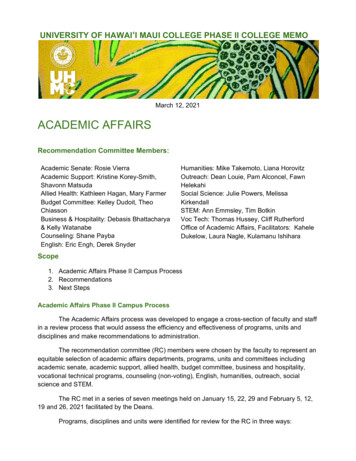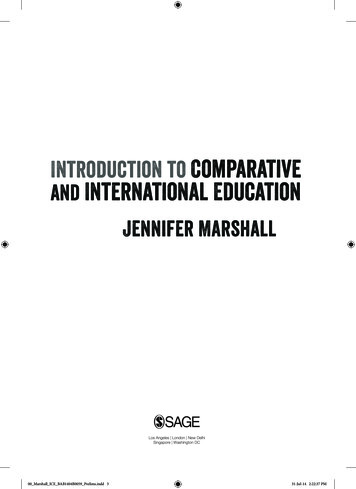
Transcription
Introduction to Comparativeand International EducationJennifer Marshall00 Marshall ICE BAB1404B0059 Prelims.indd 331-Jul-14 2:22:37 PM
CHAPTER 1AN INTRODUCTIONTO COMPARATIVEEDUCATIONThis chapter explores: What comparative education is;How the field has developed over the years;The purpose of comparative education;Who compares;The challenges of undertaking comparative research.Activity 1.1 Defining termsBefore beginning this chapter, write down a definition of comparativeeducation. At the end of the chapter, reflect on your definition. Is comparative education what you thought? How might this be similar to anddifferent from international education?Comparative education is often used interchangeably with internationaleducation. While these two fields certainly overlap, it can be argued thatthey are two distinct areas of study. There has been a long history of debate301 Marshall ICE BAB1404B0059 Ch-01 Part-1.indd 331-Jul-14 2:22:44 PM
4 INTRODUCTION TO COMPARATIVE AND INTERNATIONAL EDUCATIONpertaining to the identity of comparative and international education, oftencalled ‘twin’ fields (Bray, 2010), but what exactly is comparative educationand how is it different from international education? This chapter aims toexplain the nature and purpose of comparative education.Historical development of comparative educationIn order to define what the field is today, an understanding of the historyshaping it is important. Many contemporary academics argue of the importance in understanding the historical development of comparative educationin order to appreciate just how far the field has come from its earliest roots.Not only is there disagreement as to the definition of the twin fields, butdisparity also exists in identifying their historical roots. How far back doescomparative education go? When did it emerge as a distinct field of study?Noah and Eckstein (1969) claim that the historical development of comparative education can be identified by five distinct stages, each with itsown aims. The first stage is often referred to as ‘travellers’ tales’; stories werebrought back from foreign travel and were generally descriptive in nature.When this first stage begins is less clear but for Noah and Eckstein it pre-datesthe nineteenth century. Some writers go back as far as ancient times, citingexamples from the Greeks and Romans and in particular how they admiredthe ‘discipline of Spartan education’ (Crossley & Watson, 2003, p. 12).According to Phillips (2000), there was a large group of British travellers who fell into Noah and Eckstein’s first stage. They visited countriessuch as Germany out of ‘cultural and general curiosity’ and they wrotewith ‘varying degrees of sophistication’ (Phillips, 2000, p. 49). At this time,these tales did not systematically compare or analyse educational practiceso have been dismissed by many scholars. However, others (see Rust,Johnstone & Allaf, 2009) have asserted that while these tales may havebeen descriptive they had much value and have been harshly judged bythose who have a narrow view as to what counts as scholarly activity.Activity 1.2 Travellers’ talesHave you ever travelled to another country and come back with aneducation-related story to share? Or do you have friends who are fromanother country? Have they told you about education in their own country? Why would or wouldn’t this be classified as research?The second stage described by Noah and Eckstein (1969) begins from thenineteenth century. This phase coincides with the rise of national educationsystems in Europe. During the 1800s countries such as France, Germanyand Great Britain were establishing national systems of schooling which01 Marshall ICE BAB1404B0059 Ch-01 Part-1.indd 431-Jul-14 2:22:44 PM
AN INTRODUCTION TO COMPARATIVE EDUCATION 5eventually became free and universal by the end of the century. Manypolicy makers had great interest in the organisation and practice of education in other countries in order to help them devise their own. Noah andEckstein (1969) argue that the work conducted in this stage was still verysimilar to the travellers’ tales in previous years. Many of the writings duringthis time were ‘encyclopedic descriptions of foreign school systems’ (Noah& Eckstein, 1969, p. 5) and subjective in nature. ‘These visitors came with adistinct purpose – to learn from a foreign example and through such learning to help improve the circumstances in their home countries’ (Phillips,2000, p. 49).The third stage occurred around the middle of the nineteenth century and is still characterised by the accumulation of information in anencyclopaedic manner. However, Noah and Eckstein (1969) suggest thatthis exchange of scholars, students and publications was in the interestof promoting international understanding rather than in the interest ofadvancing one’s own educational interests.The fourth stage begins around the end of the nineteenth century. Inthis stage, a social science approach was beginning to develop as ‘studiesof foreign schooling became to a considerable extent studies of nationalcharacter and the institutions that help form it’ (Noah & Eckstein, 1969,p. 6). The recognition of the role of education in shaping society becameimportant in this stage, as did the idea of cause and effect, and thatnational character determines education.The fifth stage occurs after the First World War and coincides with therise in statistical techniques in the social sciences. The adoption of quantitative methods after the Second World War and the empirical orientationof the social sciences began to reshape comparative education (Noah &Eckstein, 1969).Activity 1.3 Historic stagesThink about how comparative education has developed using Noah andEckstein’s five stages. Can you find any similarities between them and yourown academic development? What criticisms can you think of regardingthese five stages? Do you think the field developed in a linear fashion?Similarly, in his classic book Comparative Method in Education, Bereday(1964) writes of phases in the history of comparative education. However,for Bereday the first phase begins in the nineteenth century and lasts forabout 100 years. Like many other scholars (e.g. Green, 2003; Phillips &Schweisfurth, 2008; Acosta & Centeno, 2011), Bereday believes that theFrenchman Marc-Antoine Jullien, or Jullien de Paris, as he is also known,was ‘the first scientifically minded comparative educator’ (Bereday, 1964,p. 7). Jullien’s aim was to improve French education by identifying the01 Marshall ICE BAB1404B0059 Ch-01 Part-1.indd 531-Jul-14 2:22:44 PM
6 INTRODUCTION TO COMPARATIVE AND INTERNATIONAL EDUCATIONbest schools in Europe and examining how they were organised, theteaching methods they used and what successful improvements they hadimplemented. Many writers in the field have called him the ‘father’ ofcomparative education as he was the first to use the term ‘comparativeeducation’ (Crossley & Watson, 2003) and to use formal models of analy sis (Gautherin, 1993). In Jullien’s book, The Esquisse d’un ouvrage surl’éducation compare or Sketch and Preliminary Views on ComparativeEducation, published in 1817, unlike his predecessors, he provided a‘systematic comparative classification of education systems, based onrudimentary questionnaire surveys’ (Green, 2003, p. 84). According toGautherin (1993), by using the comparative method successfullyemployed in anatomy, Jullien was trying to advance the science of education. Although his work was largely neglected throughout his lifetime,the first course on the science of education was officially introduced atthe Sorbonne in Paris in 1883 (Masemann, 2006).Bereday called this first phase in comparative education the period of‘borrowing’ because ‘comparison of the collected information was thenundertaken in order to make available the best practices of one countryfor transplantation to others’ (Bereday, 1964, p. 7).Activity 1.4 Educational borrowingWhat practices do you think early writers in the field reported on? Doyou think borrowing these practices and transplanting them in your owncountry is effective? Why or why not?For Bereday (1964), the second phase, called the period of ‘prediction’,occurred during the first half of the twentieth century and was led bythe British educationalist Sir Michael Sadler. Like Jullien de Paris, Sadlerwas also interested in improving the English education system solooked to other systems, namely those in France, the USA and Germany,in order to draw comparisons. In his quest for reform, he became‘aware of the wider social implications any kind of educational innovation must have’ (Mallinson, 1981, pp. 176–177). Scholars at this timepaid attention to the relationship between education and society andthe social causes underlying pedagogical practice. There was now ashift from cataloguing descriptive data to examining the social and cultural factors influencing education. In Kandel’s classic text, Studies inComparative Education (1933, p. xi), he writes: ‘The problems andpurposes of education have in general become somewhat similar inmost countries; the solutions are influenced by differences of traditionand culture peculiar to each.’ As a result, educators became much morecareful when transferring ideas and practice from one country to01 Marshall ICE BAB1404B0059 Ch-01 Part-1.indd 631-Jul-14 2:22:44 PM
AN INTRODUCTION TO COMPARATIVE EDUCATION 7another. Bereday (1964, p. 8) called this phase in comparative education as ‘the period of prediction because the purpose of comparativestudy was now not primarily borrowing but predicting the likely success of a system of education in one country on the basis of the observation of precedents and similar experiences of other countries’.At the time of writing his book, comparative education had onlyjust embarked on the third phase, which Bereday called the periodof ‘analysis’. Bereday (1964, p. 9) believed ‘that before prediction andeventual borrowing is attempted there must be a systematization of thefield in order to expose the whole panorama of national practices ineducation’. Early scholars, such as Kandel (1933), even called for thedevelopment of better methods in the field. There was no universalagreement as to what kind of methods and systematisation that comparativists should follow. This disagreement was evident in much of thescholarly writing in the field after the Second World War.However, critics such as Epstein (2008, p. 374) argue that the widespread view that comparative education ‘evolved mainly in Darwinianstyle stages of development’ is misunderstood. Others believe thatseparating out the history of the field into phases is over-simplistic andthat they ‘are not necessarily linear or consistent across time, cultures orindividuals’ (Crossley & Watson, 2003, p. 21). William Brickman, anotherkey figure in the field, asks us to challenge the role of Marc-AntoineJullien as the ‘father’ of comparative education and asserts that therewere, perhaps, others before him who used analytical approaches intheir comparative studies (Brickman, 2010). Despite criticism, it is widelyacknowledged that both Bereday and Noah and Eckstein’s books havecontributed greatly to the field (Bray et al., 2007).What is the early history of comparative education in other parts of theworld? Comparative education was developing in countries of Europe,North America and Asia between the latter parts of the nineteenth and theearly twentieth century (Masemann, 2006). However, the historical development of comparative education in mainland China, for example, canarguably date back further than the ‘traveller’ tales of Western Europe. Dueto its long history of civilisation, cases of ‘borrowing’ and ‘lending’ can betraced back to the Han Dynasty (206 BC–220 AD) and the Tang Dynasty(618–906 AD) where the influence of Indian Buddhism on Chinese education were evident (Bray & Qin, 2001).In the Middle East between the twelfth and fourteenth centuries, scholars travelled extensively in the Arab region and their accounts representthe first comparative education documents in the region (Benhamida,1990, in Halls, 1990). Like in the West, during the latter part of the nineteenth century, the establishment of public schooling required a moresystemic way of studying foreign education. It was not until the 1940sand 1950s that comparative education, led by the prominent Syrian Satial-Husari (1882–1968), began to develop into the field we understand asit is today (Benhamida, 1990, in Halls, 1990).01 Marshall ICE BAB1404B0059 Ch-01 Part-1.indd 731-Jul-14 2:22:44 PM
8 INTRODUCTION TO COMPARATIVE AND INTERNATIONAL EDUCATIONIn Latin America during the nineteenth century, there are examplesof ‘traveller tales’ from those such as José María Luis Mora from Mexico,Andrés Bello from Venezuela, Domingo Faustino Sarmiento fromArgentina, and José Pedro Varela from Uruguay, who looked at education practices that they could borrow from Europe and the USA (Acosta& Centeno, 2011). For example, Sarmiento, an intellectual and socialactivist in Argentina, travelled to France, Prussia, Switzerland, Italy, Spainand England to learn new ideas in his quest to bring education to themasses and improve the social conditions of women and children inparticular (Bravo, 1994).In the twentieth century, the Second World War had a tremendousinfluence on the field of comparative and international education (international education will be discussed in Chapter 7). Many internationalorganisations which undertake comparative research in education, suchas the United Nations Educational, Scientific and Cultural Organisation(UNESCO) and the World Bank, were created to help rebuild a worldshattered by war (Crossley & Watson, 2003).Comparative education societies and journalsOver the years, other organisations have played a key role in shapingcomparative education. The first Comparative Education Society (renamedin 1969 as the Comparative and International Education Society, or CIES)was formed in the USA in 1956. Other societies soon followed in Europeand elsewhere. The main purpose of the CIES is to foster cross-culturalunderstanding, scholarship, academic achievement and societal development through the international study of educational ideas, systems andpractices. The Society’s members include more than 2,000 academics,practitioners and students from around the world (CIES, 2012). The societyconsists of not only educators but also historians, sociologists, economists,psychologists and anthropologists. This multidisciplinary approach reflectsthe field at large, adding to the variety and richness of the research andactivities that the society undertakes.In 1970, the World Council of Comparative Education Societies(WCCES) was established to bring together these newly created comparative education societies (Masemann, Bray & Manzon, 2008) andcurrently meets every three years to discuss international issues in education. It is a non-government organisation (NGO) and works togetherwith UNESCO. It was created to advance the field of comparative education and also promote research involving scholars in various countries.Research topics include theory and methods in comparative education,education of women and girls, teacher education and education forpeace and justice (WCCES, 2012).Now, there are now over 36 member societies: four Africa, six Americas,16 Asia and Middle East, 16 Europe, and one in Oceania. The size and01 Marshall ICE BAB1404B0059 Ch-01 Part-1.indd 831-Jul-14 2:22:44 PM
AN INTRODUCTION TO COMPARATIVE EDUCATION 9Table 1.1Comparative education societies 1950s–1960sComparative and International Societies (1950–1970)Dates foundedComparative and International Education Society (formerlyComparative Education Society) (CIES)1956Comparative Education Society in Europe (CESE)1961Japan Comparative Education Society (JCES)1965Comparative and International Education Society of Canada1967Korean Comparative Education Society (KCES)1968membership of these societies varies, as does the year in which theywere formed; some have been established since the 1970s (e.g. the DutchSpeaking Society for Comparative Studies in Education or, in Dutch,Nederlandstalig Genootschap voor Verglelijkende Studie van Opvoedingen Onderwijs, (NGVO)); others later, such as the Gulf ComparativeEducation Society which was formed in 2008. The main goals of each ofthese societies are similar to and in line with the WCCES, which is primarily to promote research and scholarly exchange in the field of comparative education. In order to do that, many of these societies produceacademic journals and host conferences to share research and ideas.Activity 1.5 Comparative education societiesHave a look at the following comparative education society websites andtheir respective journals:The Spanish comparative education society (SEEC) available at: www.sc.ehu.es/sfwseec/index en.htmThe Australian and New Zealand Comparative and International EducationSociety (ANZCIES) available at: www.iejcomparative.org/The Comparative and International Education Society of Canada (CIESC)available at: www.iejcomparative.org/What are the stated objectives of these societies? What topics are publishedin their journals? To what extent do you feel they meet these objectives?Since their inception in the late 1950s, these societies have contributedgreatly to the advancement of the field through their research andpromotion of it, and in the 1960s, comparative education embarked ona whole new era of scholarly activity. By this time, there were a number of prominent comparativists such as Nicolas Hans, Issac Kandeland Edmund King, in the USA, Europe and elsewhere.01 Marshall ICE BAB1404B0059 Ch-01 Part-1.indd 931-Jul-14 2:22:44 PM
10 INTRODUCTION TO COMPARATIVE AND INTERNATIONAL EDUCATIONAs well as societies, a number of comparative education journals wereestablished in the twentieth century, many being the official journals ofthe societies with which they were affiliated. The first comparative education journal was produced in Germany in 1931 under three titles(German, English and French): Internationale Zeitschrift fürErziehungswissenschaft, International Education Review and RevueInternationale de Pédagogie. The journal was interrupted briefly severaltimes but started again permanently in 1955 with the English namechanged to International Review of Education (Bray, 2003a). In 1957, theComparative Education Society (now the CIES) launched their officialjournal entitled Comparative Education Review. The journal ‘investigateseducation throughout the world and the social, economic, and politicalforces that shape it [its aim is] to advance knowledge and teaching incomparative education studies’ (CIES, 2012).Methodological debatesIn the 1960s and 1970s, the field was embroiled in debates about methodology. In other words, disagreement arose as to how research in thefield should be carried out. These debates reflected what was happeningin the wider social sciences where positivism had dominated academiasince the nineteenth century. From a positivist perspective, the laws ofscience typically used to study and understand the physical world areapplied to the social world. If we can find the laws of cause and effectthat govern society, we might be able to predict and control it. Manysuch as Noah and Eckstein (1969) argued in their seminal text, Towarda Science of Comparative Education, that researchers in the field shouldadopt a positivist or scientific approach using quantitative methods. Infact, they applauded their predecessors, such as Sadler, Kandel andHans, for their qualitative attempts to explain the relationship betweensociety and education. However, they felt that in order for comparativeeducation to fulfil its potential for education planning, it had to offer ameans of reliable prediction and without a quantitative base; they feltthat this could not be suitably achieved (Noah & Eckstein, 1969).Much of the work carried out during the ‘borrowing’ phase of comparative education in the nineteenth and early twentieth century wascriticised by post-war educationalists (Crossley & Watson, 2003). Thecriticism stemmed from the fact that previous research had been mostlyhistorical, descriptive and explanatory. Many thought this ‘approachlacked scientific rigour because it failed to draw causative links betweenschools and society’ (Crossley & Watson, 2003, p. 26). Therefore, throughthe scientific approach, researchers such as Bereday (1964) and Noahand Eckstein (1969) were trying to see if it were possible to identify lawsgoverning the relationship between education and society (Crossley &Watson, 2003). Indeed, Bereday (1964) writes: ‘As in all social sciences,01 Marshall ICE BAB1404B0059 Ch-01 Part-1.indd 1031-Jul-14 2:22:44 PM
AN INTRODUCTION TO COMPARATIVE EDUCATION 11this final stage of the discipline is concerned with the formulation of“laws” or “typologies” that permit an international understanding anda definition of the complex interrelation between the schools and thepeople they serve’ (Bereday, 1964, p. 25).Activity 1.6 Scientific laws and comparativeeducationHow can you apply the scientific approach to the study of education systems and the societies that they are a part of? What are the benefits andlimitations of this approach?However, as stated previously, not everyone in the field agreed with the‘scientific’ approach being proposed. In fact, Edmund King, a professorof Comparative Education in King’s College, University of London, andeditor of the journal Comparative Education from 1978 to 1992 was onesuch critic. King (1965) believed that comparative education is reallyabout the study of human behaviour and is therefore complex.Let us take a single example from several dangerous fantasies inour field. We are sometimes invited to simplify our research workand make it more ‘scientific’ by inventing some formula or ‘theoretical construct’ of a near-mathematical type that will enable us to‘identify’, to ‘classify’, and to ‘predict’. Some misguided peopleseem to resemble unmathematical schoolboys, hoping to find aroutine formula for the magic solution of equations, or for workingout percentages and dividends. Perhaps it works in mathematics.It will not work with behaviour.(Edmund King, 1965, p. 151)King (1965) also criticised the problem approach as proposed by Bereday(1964). Bereday believed that this was an essential part of the research process. ‘It involves a selection of one theme, one topic, and the examination ofits persistence and variability throughout the representative educational systems’ (Bereday, 1964, p. 23). For Bereday, solutions to these problems can befound by examining how others in the world have solved similar ones. Infact, Kandel (1933) listed a number of problems which he felt were universalamong nations. Some of the problems posed by Kandel over 80 years ago(see below) may seem fairly relevant today, even in the ever-changing educational landscape. However, looking at them critically, were these problemsreally universal and are they still today? Furthermore, King (1965) argued thatwithout careful attention to sociological, psychological or economic perspectives, this approach could be seen as amateurish and even ‘dangerous’.01 Marshall ICE BAB1404B0059 Ch-01 Part-1.indd 1131-Jul-14 2:22:44 PM
12 INTRODUCTION TO COMPARATIVE AND INTERNATIONAL EDUCATIONKandel’s selected ‘problems of education’ (1933, p. xviii) were as follows: What is the place of private education and of private schools? What is the scope of post-elementary or secondary education? What should be the curriculum in each type of school? How are teachers prepared and what is their status? How can standards be maintained? What should be the place ofexaminations? Who shall formulate curricula and courses of study? What is the meaning of equality of educational opportunity?Bray, Adamson and Mason (2007) point out that debates concerningmethodology were not happening equally around the world and thework emanating from English-speaking countries came to dominate theliterature. By the 1980s, attempts to exert one single method overanother had subsided and the debate over methodology waned(Altbach & Kelly, 1986, cited in Bray et al., 2007). New concernsemerged in the field with the arrival of the concept of globalisation inthe late 1980s. Current debates have centred on the relationshipbetween globalisation and education and the challenges this poses forcomparative education (see Dale, 2005). This relationship will beexplored in Chapter 8.Comparative education: A discipline?Over the years, many have been concerned with whether comparativeeducation is a discipline, a field of study, an approach or a method – away of collecting data. Can comparative education really be considereda discipline? In order to consider this, the first question has to be ‘whatis a discipline?’ Traditional disciplines such as history, economics, sociology and psychology have their own departments and offer degrees inthe subject at colleges and universities. They have an accepted andestablished way of doing research and producing knowledge, often published in their own academic journals. There is no single method incomparative education nor is there any agreement as to which methodis best. In fact, Bereday wrote that ‘comparative education relies on themethods of a host of other fields, from philosophy to psychology, fromliterature to statistics ’ (Bereday, 1964, p. x).Some might ask, ‘does it really matter?’ While others see that it reallydoes, Manzon (2011) believes that this lack of clarity concerning thenature and identity of comparative education is problematic. She writes:‘How can a field of study survive, develop and perpetuate itself if itsscholarly community are unclear, much less unanimous, about their field’s01 Marshall ICE BAB1404B0059 Ch-01 Part-1.indd 1231-Jul-14 2:22:44 PM
AN INTRODUCTION TO COMPARATIVE EDUCATION 13identity, aims and contents? (Manzon, 2011, p. 2) Much of the literature inthe field focuses on this exact debate.Can students acquire degrees in comparative education like they canin other disciplines, such as history or sociology? Comparative educationwas first taught as a course or module by James E. Russell at TeachersCollege, Columbia University, USA, in 1899 (Bereday, 1963). The title ofthe course was Comparative Study of Educational Systems. Accordingto a university announcement, the course was ‘designed to present acomprehensive view of a typical foreign school system and to aid students in making intelligent comparisons of the practical workings of thissystem with other systems at home and abroad’ (Bereday, 1963, p. 189).Furthermore, during the academic year 1899–1900, special attention wasgiven to the national education of Germany as compared with characteristic features of the systems of France, England and America.Elsewhere, the first comparative education courses were taught by IsaacKandel at Manchester University, England, in 1905; by Peter Sandiford inCanada at the University of Toronto in 1913; and in the 1920s at other universities in Bulgaria, Czechoslovakia, Poland and Uganda (Manzon, 2011).Furthermore, Manzon reports that in the 1930s, comparative educationsubjects were also taught in the Far East: at Tokyo University in Japan; inChina at Beijing Normal University and at the University of Hong Kong. Inthe 1940s, similar trends were also seen in Brazil, Cuba and Australia, andby the end of the Second World War, comparative education had becomean established academic subfield of education departments in universitiesaround the world (Manzon, 2011).From its inaugural course at Teachers College at Columbia University,comparative education has had strong links to teacher training (Planel,2008), with many programmes around the world including it as an optionalor elective component of their degrees. However, recent reports suggestthat comparative education in initial teacher training has declined over theyears in Western countries (O’Sullivan et al., 2008; Planel, 2008). In theUK, at undergraduate level, comparative education can be found in general education programmes such as the BA (Hons) Education Studies andmay come under a variety of titles such as comparative pedagogy, educational systems abroad, Education in Europe, and so forth. Very often, elements of comparative education may be found in other courses on globalcitizenship, philosophy of education or in modules with titles incorporating the terms global or international. Most full degrees in ComparativeEducation are offered at Master’s level rather than undergraduate level andthe number of institutions offering this worldwide is small in comparisonto other Master’s degrees, such as those in Business Administration.Most scholars would probably now agree that comparative educationis a subfield of Education Studies. Even Bereday (1964, p. ix) writes:‘Comparative education is a young subfield in the very old discipline ofpedagogy.’ Others, such as Phillips and Schweisfurth (2008), have arguedthat comparative education is a ‘quasi-discipline’. They believe that:01 Marshall ICE BAB1404B0059 Ch-01 Part-1.indd 1331-Jul-14 2:22:44 PM
14 INTRODUCTION TO COMPARATIVE AND INTERNATIONAL EDUCATIONComparativists cover a huge range of topics which demand expertisein many areas of academic inquiry. What brings them together in anidentifiably coherent way is the common attempt at comparison, andcomparison is a method used by various disciplines rather than anactivity which can conceivably be described as a discipline in itself.(Phillips & Schweisfurth, 2008, p. 11)Colclough (2010) contends that it is largely because of the vast range oftopics within the field that comparative education is not constrained bydisciplinary boundaries. Nor is it likely or desirable to be so. In fact,Crossley and Watson (2003, p. 66) believe that a
Jullien as the ‘father’ of comparative education and asserts that there were, perhaps, others before him who used analytical approaches in their comparative studies (Brickman, 2010). Despite criticism, it is widely acknowledged that both Bereday and Noah and Eckstein’s books h
